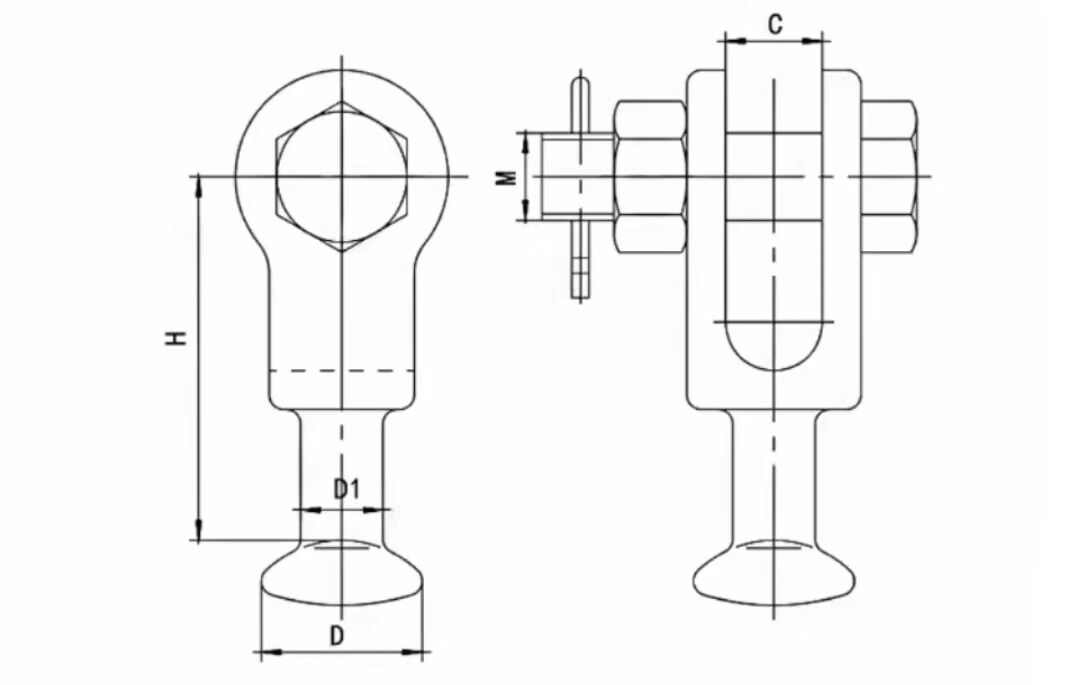1. 高強度素材
一般的に鍛造および溶融亜鉛めっきプロセスを通じて高品質鋼で作られており、高強度と優れた靭性を備えており、大きな引張力に耐えることができます。例えば、一般的なモデルの公称破断荷重は70 kN以上に達します。また、溶融亜鉛めっき処理により優れた耐食性を発揮し、高温多湿、塩害、または工業汚染などの複雑な屋外環境に対応できます。
2. 合理的な構造
ボールヘッド部分は絶縁体のボウルヘッドとよく適合し、しっかりとした接続を保ちながら多方向への柔軟な回転が可能。サスペンション・ループ部分は他の金具との接続が容易となる設計で、安定した信頼性の高い連結を提供する。この構造設計により設置作業が簡略化されるだけでなく、クランプの動的荷重への適応性も高まり、送電線での長期的な接続安定性を維持する。
1. 確実な接続
絶縁体および他の金具と密に接続し、長期間使用しても緩みにくく、接続不良による線路障害を効果的に低減する。精密設計されたボールアンドソケット機構と確実なファスナー設計により、継続的な振動や動的荷重下でも安定した機械的性能を発揮し、電力網の信頼性を高める。
2. 高い汎用性
さまざまな仕様やモデルがあり、絶縁体やその他の金具の異なる種類およびサイズとインターフェース可能で、複数の電圧クラスの送電線に適応できます。この柔軟性により、低圧配電網から高圧送電システムまで、多様な電力プロジェクトに適しており、国際規格との互換性を確保することでグローバルグリッドへの統合が容易になります。
3. 手入れが簡単
丈夫な素材と安定した構造のため、通常の運転条件下では最小限のメンテナンスで済み、送電線のメンテナンスコストを削減します。腐食防止の表面処理と耐久性のある設計により、定期的な点検や防錆処理の必要性がなくなり、保守作業が困難な遠隔地やアクセスしにくい地域においても最適です。
1. 接続機能
主に直角懸垂プレートなどの金具と絶縁子を接続するために使用され、送電線の架空系統において絶縁子ストリングの重要な接続点として機能し、電柱やタワー上での導体の懸垂または固定を可能にします。このモジュラー接続は全体的な架空システムの機械的完全性を保証し、絶縁子ストリングおよび補助部品の組立を支援します。
2. 荷重伝達
導体の重力、張力、風荷重を電柱やタワーへと伝える役割を果たし、線路の機械的なバランスを維持し、さまざまな作業条件下で安定した運転が行えるようにします。クランプの高強度構造は動的および静的な荷重を効率的に分散させ、応力集中による構造破損を防ぎ、極端な気象条件時にも線路の安定性を確保します。
3. 線路の動きへの適応
ボールヘッド設計により、絶縁子串が所定の範囲内で自由に回転可能となり、熱膨張・収縮、風による振れ舞い、またはその他の要因によって引き起こされる導体の変位に対応できます。この柔軟性により、線路に余分な機械的ストレスがかからず、過度な張力による損傷を防ぎ、特に長距離架線や温度変動が大きく風速が高い地域において、送電システムの安全性と安定性を向上させます。

| 国家電網モデル | 85モデル - 標準 | 接続マーク | 全サイズ (mm) | 公称切断荷重(kN) | |||||
| C | D1 | D | M | H | |||||
| QS-0775 | Q-7U | 16 | 20 | 17 | 33.3 | 16 | 75 | 70 | |
| 記載された測定値はすべて手作業で取得したものですので、若干の誤差が生じる場合があります。最終的な寸法については実物を基準としてください | |||||||||
弊社の専門営業チームがお客様のご相談をお待ちしております。

著作権 © 広州新創聯瑞国際貿易有限公司 すべての権利予約済み。 - プライバシーポリシー- わかったブログ